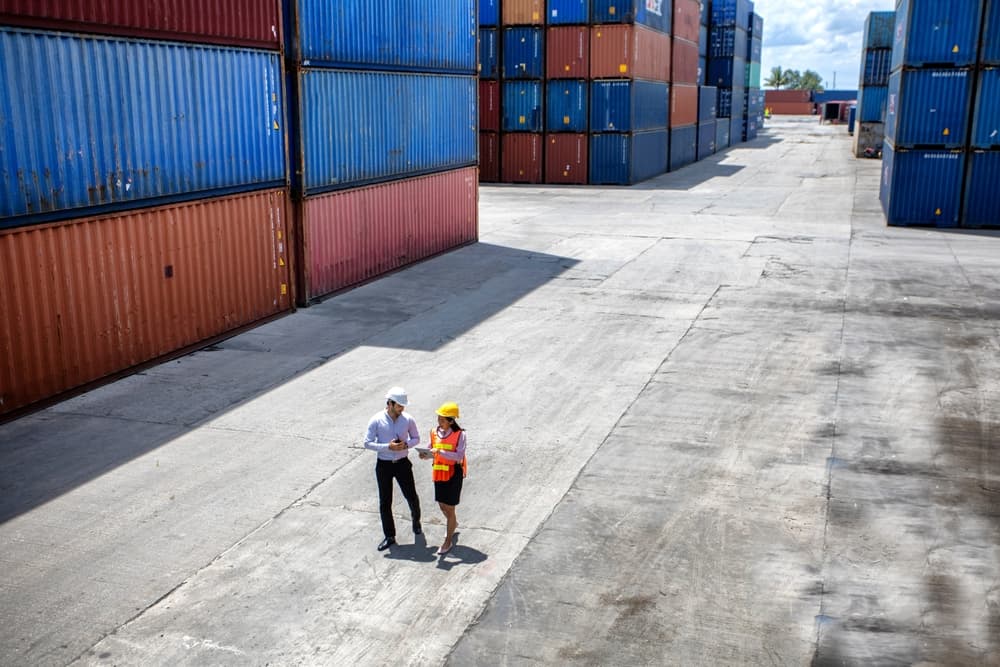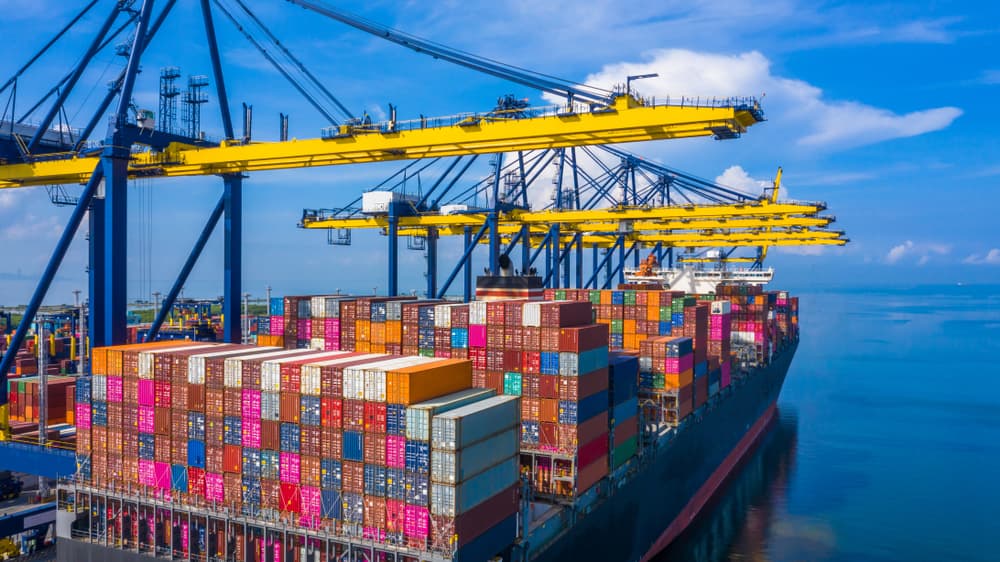Organizations that ship large, heavy items must turn to freight shipping to transport packages. Learn what freight shipping is and how it works.
When we think of direct-to-consumer shipping, we think of packages, often delivered by USPS, FedEx, or Amazon. This, the most common consumer shipping option, is known as parcel delivery. Parcel delivery items are boxes, bags, or anything that might be carried to a door rather than dropped off at a loading dock.
Small items like books, clothes, and household goods are ideal candidates for parcel service. But what if you need to ship furniture, or auto parts?
These oversized loads require special handling known as freight shipping. Not only is freight generally the most cost-effective solution for large items, but it’s also often the only solution. So, what is freight shipping, and how does it benefit your business?
What is freight shipping?
Freight shipping, or “freight transportation,” is the movement of large or heavy goods across long distances. The most common transportation methods include:
- Airplane
- Cargo ship
- Railroad
- Commercial truck
In some cases, freight carriers use “intermodal transportation,” which combines multiple modes of transportation — for example, shipping a package overseas by boat and then to an inland warehouse via a freight truck.
Take rail shipping. Imagine loading an oversized item onto a truck, driving it 80 miles, and unloading it onto a train. The train moves the freight another 1,800 miles and offloads it onto another truck for the last 20 miles of the delivery. While seemingly inefficient, there are significant cost savings to loading and unloading the freight multiple times rather than just driving it across the country.
“Multimodal transportation” is similar to intermodal in that it also involves moving goods via multiple transportation modes. However, a single provider is responsible for and coordinates the shipping process in multimodal transportation. This option provides shippers the convenience of only interacting with a single logistics provider.
Freight shipping services are the backbone of worldwide logistics networks, which link manufacturers with suppliers, consumers, retailers, and wholesalers. Without this complex network of stakeholders, consumers wouldn’t have access to such a wide variety of goods.
How does freight shipping work?
Freight shipping companies evaluate shipped goods based on how easily they’re loaded, handled, and moved. Items are then grouped into one of 18 freight classes and assigned a code using numbers from 50 to 500.
Freight class is determined by the National Motor Freight Traffic Association (NMFTA). The classification system, known as the National Motor Freight Classification (NMFC), is based on four key factors:
- Density: The weight of the item in relation to its size (cubic footage). To calculate density, divide the weight of the package, in pounds, by its total cubic feet. Goods that are heavy but take up less space have a lower freight class, making them less expensive to ship.
- Stowability: How easily an item can be transported with other cargo. Items that are hazardous, or have an irregular shape that prevents them from being easily stacked, have a higher freight class.
- Handling: Special care required to handle the item. If an item is fragile, hazardous, or requires unique attention during transport, it has a higher freight class.
- Liability: The risk associated with transporting the item. If an item is likely to damage other cargo, is at high risk of theft, or could cause harm to workers, it has a higher freight class.
Because freight shipping involves oversized goods, it’s a little more complex than putting an item in a box and taking it to the post office. You need the right infrastructure for handling freight, which involves choosing the right vehicles, loading and unloading equipment, and delivery methods.
Here are some important questions to ask yourself when planning for freight shipping:
- How will I pack the items?
- What freight classification should I use?
- Will I use a paper bill of lading or create a digital shipping label?
- Which shipping company will I use?
Benefits of freight shipping
Freight shipping may not be necessary for your business, but it could be the best option for the reliable delivery of large goods. If you’re weighing freight against another option, consider these benefits:
Low costs
With multiple shipping options available, you can choose the route and delivery method that keeps cost low. Some companies further reduce costs by reusing pallets or making their shipments stackable, allowing handlers to fit more items into a single load.
Reduced environmental impact
The ability to use intermodal transportation gives you more control over emissions, as you can choose the shipping options that result in the least CO2. Ocean freight, for example, has a lower environmental impact than air. Ships maximize every square foot of surface area and produce less than one-twentieth of the carbon emissions of planes. For eco-conscious business owners, you can offset this even further with carbon-neutral shipping options and carbon shipping offset programs.
Better restocking capabilities
With parcel shipping, a few boxes may show up one day, and the remaining boxes could arrive much later. This makes it difficult to maintain appropriate inventory levels and fulfill customers’ needs. When you use freight shipping, every item in the shipment arrives simultaneously, so it’s easier to replenish inventory.
Reduced risk of product damage
Regular parcels often arrive with some type of damage, from crushed boxes to torn envelopes, due to handling mishaps. In some cases, the damage extends to the product inside, leaving the customer with a negative impression of the seller. While accidents do happen, freight shipments are well-protected and handled extra carefully because of their size and weight, making them more likely to arrive intact. Rather than shipping a heavy object with standard ground shipping, you may want to ship with an experienced freight company with the know-how to keep your items safe.
Freight shipping methods

Choosing freight also means selecting a suitable shipping method for your needs. Here are the most common methods and transportation types:
Full truckload (FTL)
FTL shipping involves filling a semitrailer with products instead of sharing a truck with other companies. If your business wants to ship large quantities of goods, FTL shipping is the most cost-effective option. It also tends to be faster than other freight shipping methods because the trailer is reserved solely for your goods and typically follows a direct route from origin to destination.
However, FTL isn’t the best option if you want to ship small quantities of freight that don’t take up a full load, as it’s often more expensive than LTL shipping.
Less-than-truckload (LTL)
LTL freight shipping is ideal for companies that don’t have enough freight to justify waiting to fill a semi-truck. With this shipping method, you share a truck with other companies, limiting your shipping expenses. The main drawback of LTL shipping is that it’s not as fast as FTL. Trucks make multiple stops and may delay the arrival of your goods.
Partial truckload
Partial truckload (PTL), also known as “volume LTL,” falls somewhere between LTL and FTL shipping. Like LTL shipping, partial truckload is well-suited to companies wanting to move smaller quantities of goods. However, volume LTL usually has very particular size requirements and requires a freight class (while LTL doesn’t).
Ultimately, PTL shipping provides a balance between LTL's cost-efficiency and FTL's faster transit times.
Air freight
Air freight is the fastest shipping process — and the most expensive. It’s ideal for time-sensitive shipments that need to arrive at their destinations in just a few days. This method makes it easier to access small and inland countries without large or established shipping ports.
However, when shipping by air, you need to consider the weight of your cargo carefully. Planes tend to have lower weight limits than ships or train cars, so you may be unable to rely on air freight if you want to ship extremely heavy or bulky items.
Expedited
“Expedited” isn’t so much a means of shipping as it is a shipping speed. Expedited deliveries are among the fastest types of freight shipping, and can be applied to orders traveling by ground, sea, or air. You can think of expedited shipping as a “rush order” — you pay a premium to ensure goods arrive faster than typical transit times
Speed is the most obvious benefit, but expedited shipping items are also usually more secure. Fewer people handle the items, protecting them from theft and damage. Expedited shipping also gives you an opportunity to increase customer satisfaction with a guaranteed delivery date. The main disadvantage of expedited shipping is the high cost — so unless you’re shipping perishable items or making other time-sensitive deliveries, you may want to try something less expensive.
Freight shipping transportation types

When it comes to moving large items, there are three main types of transportation.
Dry bed
Dry bed transportation is used for nonperishable items that can’t travel on a flatbed. Dry vans carry furniture, clothing, cosmetics, medical devices, and other goods. They’re also used to ship foods and beverages with a long shelf life, such as bottled water and dried pasta. This method involves attaching a full shipping container to the back of a truck. Dry bed shipping is ideal for large shipments, as many carriers accept loads weighing up to 45,000 pounds. However, items can only be loaded and unloaded from the back of the bed.
Flatbed
Flatbed shipping involves loading goods onto an open platform. If you’ve ever traveled on a highway, you’ve probably seen a flatbed with lumber, pipes, and other items that don’t need much protection from the elements. Flatbeds can haul oversized loads that don’t fit within the confines of a dry bed, and can be loaded from all sides, plus the top (via crane), making them a more versatile option than dry bed shipping.
Temperature control
If you need to keep goods at a certain temperature, temperature-controlled shipping is the way to go. Frozen foods, medications, and fresh produce are a few examples of products that require strict temperature control during the shipping process. Note that refrigerated trucks tend to have lower capacities than dry beds, which may further increase expenses.
Factors influencing freight shipping costs
While it’s impossible to predict shipping costs to a T, understanding what makes a shipment more or less expensive helps you make informed transport decisions. Here are four factors that affect freight costs:
- Weight and size: Shipping companies charge a premium to transport bulky goods. If you sell extremely heavy products or your items have unusual dimensions, be prepared to pay extra for shipping.
- Distance: The farther a shipment has to travel, the more fuel it uses. Long trips also put extra wear and tear on trucks and other shipping vehicles, so shipping items across significant distances costs more.
- Freight class: If you choose LTL shipping, your freight class will affect the cost of each shipment.
- Transportation method: Shipping companies spend extra to purchase specialized freight transport vehicles, such as refrigerated trucks, and keep them running. Expect to pay a premium for temperature-controlled shipping compared to dry bed or flatbed transportation.
FAQs
What is a bill of lading?
A bill of lading is similar to the receipt you receive when you buy something. Provided to you by the carrier, it lists the type of freight in the shipment, the number of items, and the intended destination.
What is a load tender?
A load tender reduces shipping costs by allowing a shipper to offer cargo to multiple transportation companies. Each company bids on the shipment, allowing you to choose the cheapest bid.
What is freight forwarding?
A freight forwarder is a third party who handles shipping logistics on your behalf. Freight forwarding typically entails arranging to have goods shipped via multiple carriers and/or transportation methods. The freight forwarder acts as an intermediary, providing several supply chain services to its customers, including liaising with carriers.
Use technology to maximize efficiency
When looking for a freight partner, it's not only essential to consider their prices, it’s also vital to evaluate their technology.
Manual processes slow things down and make your logistics activities more expensive. Orderful offers an innovative cloud electronic data interchange (EDI) platform to help companies streamline their supply chain efforts and minimize costs. Speak with an expert for guidance on choosing an EDI platform that integrates seamlessly with your freight shipping provider’s software.
